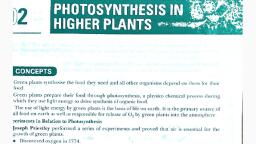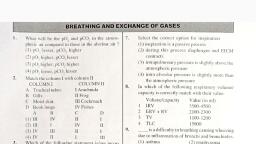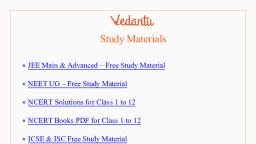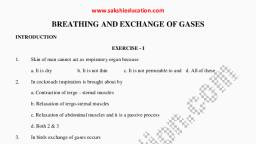Page 1 :
‘ t 14 due to bacterin |, © Proumonia tt isacute infection or inllammation of the alveoli of the lungs du a Titty,, ‘i s premmoniae, Alveoli become acute ly inflamed and most of air space oF He Alvegy, , . - PANN rgasen! ATE, , is HNtedd with Mrid and dead white blood corpuscles limiting Base us exch ang, , @ Mountain Sickness is the condition charactertse d by the ill effect of hypoxia (shortage ,, oxugen) in the tissues at high altitude commonly to person olng to high altitude for th, fist time., , @ Symptoms- i f, ©) Loss of appetite, nausea, and vomiting occurs due to expansion of gases in digesy,, , system., (i) Breathlessness occurs because of pulmonary oedema., (iii) Headache, depression, disorientation, lack of sleep, weakness and fatigue., , ote: Oxygen content: Total volume of Oy in 100 mL. of whole blood ie., volume of Oy in phyg,, solution form and oxyhaemoglobin form is equal to 19.7 + 0.3 = 20 mL of OnyBen, , gen capacity: Maximal amount of Oy that can be held by the blood at 760 mm ;, , pressure and 37°C, Oxygen capacity is about 20 mL/100 mL., , , , , , , , Ans., , 4., Ans., , Ans., 6., Ans., , 78 | Biology-Xl: Term-2 i, , , , , , Define vital capacity. What is its significance? F ani, Vital capacity is defined as the maximum volume of air a person can Dieae . in after a for,, expiration or the maximum volume of air a person can breathe out after a forced Mspiratis,, It represents the maximum amount of air one can renew in the respiratory system in a Sing, respiration. Thus, greater the vital capacity more is the energy available to the body., State the volume of air remaining in the lungs after a normal breathing. ;, , When a person breathes nor mally, the amount which remains in the lung after normal expirat, is called functional residual capacity. It is the sum. of residual volume and the expiratory res,, volume (FRG = RV + ERV). Itis about 2100 — 2300 mL of air., , Diffusion of gases occurs in the alveolar region only and not in the other parts of respira,, system. Why? . ., , For efficient exchange of gases, respiratory surface must have certain characteristics such as, , (i) It must be thin and permeable to respiratory gases., , (i) It must have large surface area., (ii) It must be highly vascular., , Only alveolar region has these characteristics. Thus, diffusion of gases occurs in this region ¢ |, , What are the major transport mechanisms for CO,? Explain., , Nearly 20-25 percent of CO, is transported by haemoglobin of RBCs, 70 percent of it is cary, as bicarbonate ion in plasma and about 7 percent of CO, is carried in a dissolved state throy, plasma. COg is carried by haemoglobin as carbamino- haemoglobin., , What will be the pO, and pCO, in the atmospheric air compared to those in the alveolar, (a) pO, lesser, pCO, higher (6) pO, higher, pCO, lesser, , (c) pO, higher, pCO, higher (d) pO, lesser, pCO, lesser, , (0) pOs higher, pCO, lesser, , , , , , Explain the process of inspiration under normal conditions., Inspiration is initiated by the contraction of diaphragm which increases the volume of the!, chamber in the antero-posterior axis. The contraction of external inter-costal muscles lilt, the ribs and the sternum causing an increase in the volume of the thoracic chamber. The 0, increase in the thoracic volume causes a similar increase in pulmonary volume. An, in pulmonary volume decreases the intva-pulmonary pressure to less than the aunosp), pressure which forces the air from outside to move into the lungs, i.e., inspiration.
Page 2 :
_—, , jo erepetetiont eogpertated?, , ties, Prank t reieegere promi #, , geben, ena fe the offert of PON), on meg gen transport?, , ea), & fotenseable fre Aiee, itigh 7 y Fives tation of oxygen from the oxyhaemoglobin, , what happens ter the respiratory process in a man going up a hill?, , treatheng will incres ¥ F, gare 1A Torerervereg Wl increase in order ty supply sufficient oxygen to Blood hecanse air in, asnenns region deficient in ruy gen , , , one, , What b the dtr of gateous exchange in an insect?, , tram eae Tracheal resperation) is the site af Haseous exchange in an rreect, , Define oxygen dissociation curve, Can you suggest any reason for its sigmoidal pattern?, , Tee reationship between the partial pressure of oxygen (pO,) and percentage saturation of the, , fuermogiadan with oxygen (Oo) is graphically illustrated by a curve called oxygen haemoglobin, , dice ation curve (also called oxygen dissociation ¢ urve)., , The sigrenedal patrern of oxygen haemoglobin dissociation curve is the result of two properties:, , fi) Minimal loss of oxygen from haemoglobin occurs above pO, of 70-80 mm Hg despite, , senificamt changes in tension of oxygen beyond this. This is depicted by relatively flat, portwn of the corve., , , , (a) Any further decline in pO; from 40 mm Hg causes a disproportionately greater release of, cnygen from the haemoglobin. It results in the steeper portion of the curve and causes the, carve to be sigmoid, , {2 Have you heard about hypoxia? Try to gather information about it, and discuss with your, friends., Hyprnua isa condition of oxygen shortage in the tissues. It is of two lypes:, , , , , , , , , , , , , , , , , , , , , , Are, @) Artificial hypoxia: It results from shortage of oxygen in the air as at high altitude. It causes, monntam sickness characterised by breathlessness, headache, dizziness and bluish tinge on skin., (i) Anaemic hypoxia: [1 results from the reduced oxygen carrying capacity of the blood due, to anzetnia or carbon monoxide poisoning. In both cases, less haemoglobin is available for, carang Oz., 13, Distingoish between, @ IRV and EXV, Gi) Inspiratory capacity and Expiratory capacity, Gii) Vital capacity and Total lung capacity, Aces. (6), 5. No. RV ” y ERV, J fr is the extra amount of air that can be| It is the extra amount of air that can be, inspired forcibly after a normal inspiration. | expired forcibly after a normal expiration., Thus it #3 forced inspiration. Thus it is forced expiration., 2. | It is about 2500 to 3000 mL of air. It is about 1000 mL to 1100 mL of air., (a), 'S Mo. Inspiratory capacity Expiratory capacity, i, | fe is the total volume of air that can be | It is the total volume of air a person can, tibaled after a normal expiration. expire after a normal inspiration., % Sr includes tidal volume and the inspiratory | It includes tidal volume and expiratory, ~ reserve volume (IC = PV + IRV). reserve volurae (EC = TV + ERV)., Le | Sets about Ab wo 4500 mL of air, It is about 1500 to 1600 mL of air., , , , , , , , , , Breathing and Exchange of Gases | 79
Page 4 :
Alveolar wall, ~ (one-celled thick), , Airflow (in/out), , Alveolar cavity, , () Name the process shown in the diagram., (ii) What feature is seen in the above structure that helps in the above process?, (ii) Why does oxygen diffuse in the capillaries?, | (iz) Name the principle of exchange of gases., (v) When is the breathing rate at its lowest?, dns. (i) Gaseous exchange, (i) Alveoli is thin and richly supplied with blood vessels that help in gaseous exchange., (i) Partial pressure of oxygen is high in alveoli than blood so it diffuses from alveoli to blood., | (iv) Diffusion, (z) Breathing rate is lowest while we are sleeping., , 3. Study the diagram given below and answer the questions that follow:, , Percentage saturation of haemoglobin with oxygen, , , , O° 20 40 60 80 100, Partial pressure of oxygen (mm Hg), , @ Identify the graph shown above. What is its shape?, List the factors that will shift the graph towards right., (iti) How much of oxygen is delivered to tissues by 100 mL of blood?, , Breathing and Exchange of Gases | 81
Page 5 :
oad, , , , |, ad, , = & major percentage (97%) of O, is transported by RBCs in the blood. Howidoes ie, remaining percentage (3%) of Oy transported? [NCERT Exemp! lar}, , iS (1) Oxvgen dissociation ¢ urve; sigmoid, © Om ee the cond, ii) Low pOy, high pCOy, high H concentration and higher temperature are the conditions, that are favourable for dissociation of oxygen from the oxyhaemoglebin- |, (a) 5 mL of O,, “ Ne - a jasma. |, ©) The remaining 3 percent of Og is carried in a dissolved state through the plasr, JESTIONS=, . w ~— %, What happens to the air as it passes the nostrils?, , . st parti alling, Ans. As air passes over the membranes, it is warmed and moistened. Dust partic les falling on the, , sticky surface are swept out by cilia, towards the throat, where they are either swallowed o,, , coughed up. This removes most of the large foreign particles from the air. :, |, , (NCERT Exemplar), , hrough which gases Move passive|,, |, , 2. (@) What is exchange of gases?, (é) State the different modes of CO, transport in blood., Ans. (i) The exchange of gases is defined as the physical process t, by diffusion across a surface., (#) COg is carried by haemoglobin as carbamino-haemo;, 70 percent of it is carried as bicarbonate. About 7 perce, state through plasma., 3. Compared to O,, diffusion rate of CO, through the diffusion membrane per unit difference i;, partial pressure is much higher. Explain. [NCERT Exempla;, Ans. Solubility is an important factor deciding diffusion rate. As the solubility of COy is 20-25 tine, higher than O,, diffusion of CO, through the diffusion membrane per unit difference in parti:, pressure is much higher., 4. (i) Why carbon dioxide diffuses to alveoli from capillaries? |, (éi) What is the percentage of O, in inspired and expired air? j, Ans. (i) Intra pulmonary pressure is lower in the alveoli than the capillaries so the carbon dioxid!, will diffuse to alveoli from the capillaries., (ii) Inspired air has 20.84% Oy and expired air has 15.70% of Oo., , globin (about 20-25 percent) where, nt of COg is carried in a dissolve., , ], 5. (i) State the role of apneustic centre in the brain. i, |, , (ii) What are the factors that affect the breathing rate?, Ans. (i) Apneustic centre is present in the lower part of the pons varolii of the brain. It increases ty,, , duration of inspiration. |, , (ii) Age, gender, size and weight, exercise, anxiety, pain, the effect of some medicines, smoki, habits and excitement level are among them., 6. Differentiate between bronchus and bronchiole., , , , , , , , , , , , , , , , Ans., 5. No. Bronchus Bronchiole, 1. | It has comparatively less sub-epithelial | It has comparatively more sub-epithe |, lymphoid ussue | lymphoid tissue. |, 2. It has C-shaped cartilaginous rings over | Cartilaginous rings are absent. i, the walls which provide flexibility A, , , , , , s, , 7. The rate of respiration usually depends on CO, -tension of the arterial blood. Give me i, > bre, , Ans. Normally, an increased concenuation of carbon dioxide is the strongest stimulus, a, aon |, , more deeply and more frequently. Conversely, when the carbon dioxide concenu, blood is low, the brain decreases the frequency and depth of breaths.


































































